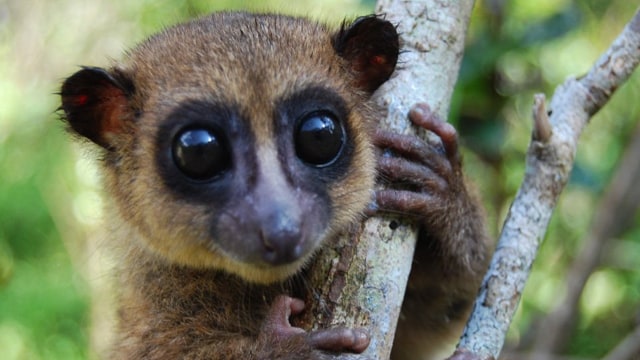Classification of animal kingdom
 Madame Berthe's mouse lemur (Microcebus berthae) or Berthe's mouse lemur is the smallest of the mouse lemurs and the smallest primate in the world; the average body length is 9.2 cm (3.6 in) and seasonal weight is around 30 g (1.1 oz). Microcebus berthae is one of many species of Malagasy lemurs that came about through extensive speciation, caused by unknown environmental mechanisms and conditions.
Madame Berthe's mouse lemur (Microcebus berthae) or Berthe's mouse lemur is the smallest of the mouse lemurs and the smallest primate in the world; the average body length is 9.2 cm (3.6 in) and seasonal weight is around 30 g (1.1 oz). Microcebus berthae is one of many species of Malagasy lemurs that came about through extensive speciation, caused by unknown environmental mechanisms and conditions.
This primate is found chiefly in the Kirindy Forest in western Madagascar. After its discovery in 1992 in the dry deciduous forest of western Madagascar, it was initially thought to represent a rediscovery of M. myoxinus, but comparative morphometric and genetic studies revealed its status as a new species, M. berthae.
This lemur is named after the conservationist and primatologist Berthe Rakotosamimanana of Madagascar, who was the Secretary General of the Groupe d'Etudes et de Recherche des Primates (GERP) from its founding until her death in 2005.
Physical Description
Microcebus berthae has short, dense dorsal pelage that is bicolored cinnamon and yellow ochre. The middorsal stripe is tawny in color. The midventral area of this species is chamois in color while the flanks are a mixture of pale chamois and light pale neutral gray. The dorsal and ventral underfur is neutral blackish neutral gray in color. The tail has short hair that is tawny. The crown and ears are also tawny in color. The orbits are surrounded by a narrow dark band. The area between the eyes is cinnamon in color. The hands and feet are dull beige.
Distribution and Habitat
Madame Berthe's mouse lemur, which is known to live in Kirindy Forest in Madagascar, is also found to inhabit the Reserve Speciale d'Andranomena. It is also suggested that they live in Analabe, given the spotted distribution of the series. Madame Berthe's mouse lemurs use the tangles of tree vines to sleep in. Because of its limited spread, it is thought that they are specialist creatures that will only live in that one specific environment. Another idea suggests that they most likely compete with M. murinus, chiefly for resources.Because of the high rate of deforestation in the surrounding Menabe forests (52%) between 1985 and 2000, less than 22,000 hectares (54,000 acres) of inhabitable forests remained between Kirindy Park, the Tsiribihina River, and the Reserve. Given that this lemur occurs at 0.36 lemurs per ha, it is estimated that about 7,920 mouse lemurs were left in the area in the year 2000. With deforestation continuing to occur on the island nation, the species is listed as endangered, at best.

Comments
Post a Comment